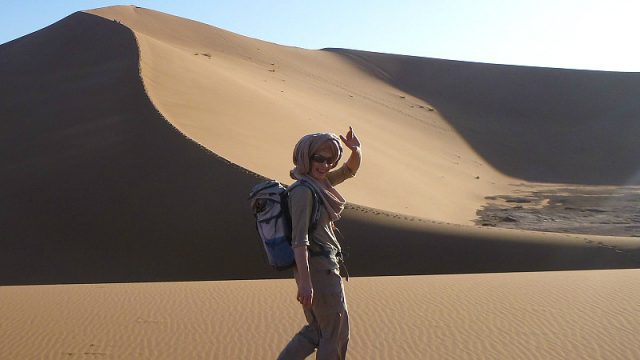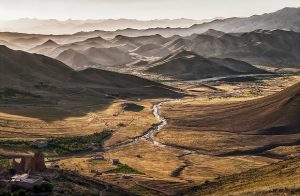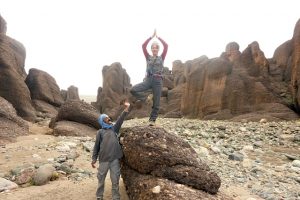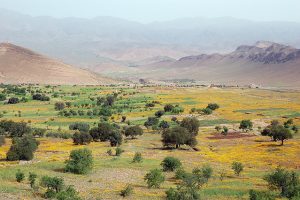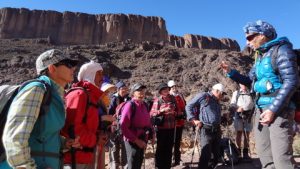Swiss trekking guide Sissi de Giuli Jadid spends half the year leading tours in southern Morocco. She runs a tour company, Zafrani, with her Moroccan partners in the picturesque town of Taliouine. As well as being Africa’s saffron capital, Taliouine is a base for trekking in the Anti Atlas, the relatively little-visited range between the High Atlas and the Sahara. In this Q&A session, Sissi gave writer James Bainbridge her top tips for visiting southern Morocco and hiking the Anti Atlas.
Why is the Anti Atlas range good for trekking compared with the more famous High Atlas?
The Anti Atlas is a different world! I love the sense of space in this vast landscape on the edge of the Sahara. The Anti Atlas is a major, 660km-long massif, which I would divide into a few zones, each with a very different character. In such an immense area, the southwest and northeast of the range experience very different weather conditions, which are reflected in the landscapes, the people and their way of life.
At first glance, these mountains seem dry and empty – apart from the greener Tafraoute region, where argan trees grow thanks to the Atlantic Ocean’s relative proximity. Yet when one penetrates into the mountains, they are culturally very interesting, with local people still living as they have for centuries. Water is scarce and precious here, and local farmers conserve and use it with an ancestral knowledge of irrigation, utilising an ancient network of canals and magnificent oases. They are experienced enough to take the risk of sowing and ploughing vast hillsides, confident in the knowledge that irrigation will come in the form of rain or snow.
For the Berber population, Islam is dominant and still dictates social customs. Every village is affiliated with a zaouia (Islamic monastery), where the villagers take sakât (charitable donations) from their agadirs (storehouses) during the local moussem (saint’s day). In the Jbel Saghro area you also find the Ait Atta tribe, some of Morocco’s last nomadic people, who spend the summer months in the cooler central Atlas.
The range is also a paradise for amateur geologists with diverse and incredible rock formations; palaeontologists, with numerous fossils to discover in the exposed rock; archaeologists, for the many ancient rock engravings; anthropologists, who can observe the local population sculpting the landscape with their agricultural practices; and botanists, with many endemic plant species.
What are your top tips for trekking in the Anti Atlas?
It is difficult to organise a multiday hike alone in the Anti Atlas, because of the scant information, the lack of recent and precise maps, and the scarce tourist infrastructures in the massifs. Furthermore, in out-of-the-way villages, people mostly speak Berber and communication can be challenging. Progress is being made on the infrastructure, but it remains sensible to contact agencies and local guides, who will help you communicate with the local people. They also take care of the organisation and ensure you discover the most interesting areas.
A new formation of nature guides has been created in Ouarzazate, High Atlas to address the lack of qualified local guides. I hope this will encourage the sustainable development of tourism in this vast region, and bring a welcome extra income to a population mostly living below the poverty line.
It is worth combining a trek with a 4×4 adventure – the Anti Atlas is well known for its 4×4, motorbike and mountain bike routes.
What is your favourite trekking route in the Anti Atlas?
A difficult question! There are so many routes, because Morocco offers such varied regions with trekking possible year-round.
For people trekking in Morocco for the first time, I often recommend the six-day hike to our ‘secret garden’: Jbel Siroua (3305m). A small volcanic massif between the High Atlas and Anti Atlas, it is suitable for all levels of hiker, with four to five hours of walking each day – apart from the tougher ascent of Siroua, which is optional. The route passes welcoming villages, beautiful terraced fields and highly varied, often spectacular landscapes, including three valleys. This is saffron country, where the precious spice is grown at altitude, and magnificent villages, kasbahs and agadirs dot the landscape.
At the eastern end of the Anti Atlas, Jbel Saghro (2712m) is a magnificent four- to five-day trek, with incredible rocky landscapes and professional local guides.
For families, I always recommend a trek in Sahara, a vast universe where children love the immense playground of dunes. Its sense of unlimited space and peace also makes it an ideal place for yoga courses, meditation, dances and so on. Visiting the Sahara is important to me and I try to walk there as often as possible, spending time with my family and friends in the desert environment, which is so different from the rest of Morocco.
What’s the best time of year to visit the Taliouine area?
At the beginning of spring, almond trees embalm the bottom of the valleys; later, the high mountain pastures and summits are strewn with small, brilliantly coloured flowers. Do not miss the saffron harvest in October, especially the Taliouine Saffron Festival in late October or early November. The summer is stiflingly hot in the low valleys, but pleasant at altitude – reached by trekking or driving. In winter, snow can cover the summit of Siroua, but the low valleys are pleasant. Trekking in the Anti Atlas is best in the autumn, winter and spring.
Tell us about an off-the-beaten-track experience in the Anti Atlas.
Ahmed, a saffron grower, welcomes travellers to his family home in the farming village of Tislit, overlooking the fabulous gorge of the same name – a jewel of the Siroua area. You experience daily life there, making bread, looking after the goats, cutting grass to feed the animals and picking saffron flowers. Ahmed’s lounge doubles as a dormitory and the bathrooms are basic, but you receive a warm and charming welcome, making this an ideal place for adventurous families to spend a night or two.
What makes Morocco a special country?
For me, it’s the people: the endearing quality of the Moroccan people is their warm hospitality, which they see as their personal duty to offer. Their kindness always leaves our guests with beautiful memories.
The regional diversity allows travellers to take different journeys throughout the year, with the incredible beauty and diversity of the landscape from the north to the south of the great chain of the Atlas Mountains. Many activities are possible thanks to Morocco’s culture, mountains, Mediterranean and Atlantic coasts, and the vast playground of the Sahara.
Another major bonus is Morocco’s proximity to Europe, from where it can be reached on a budget flight or ferry, and travel here is easy to organise.
